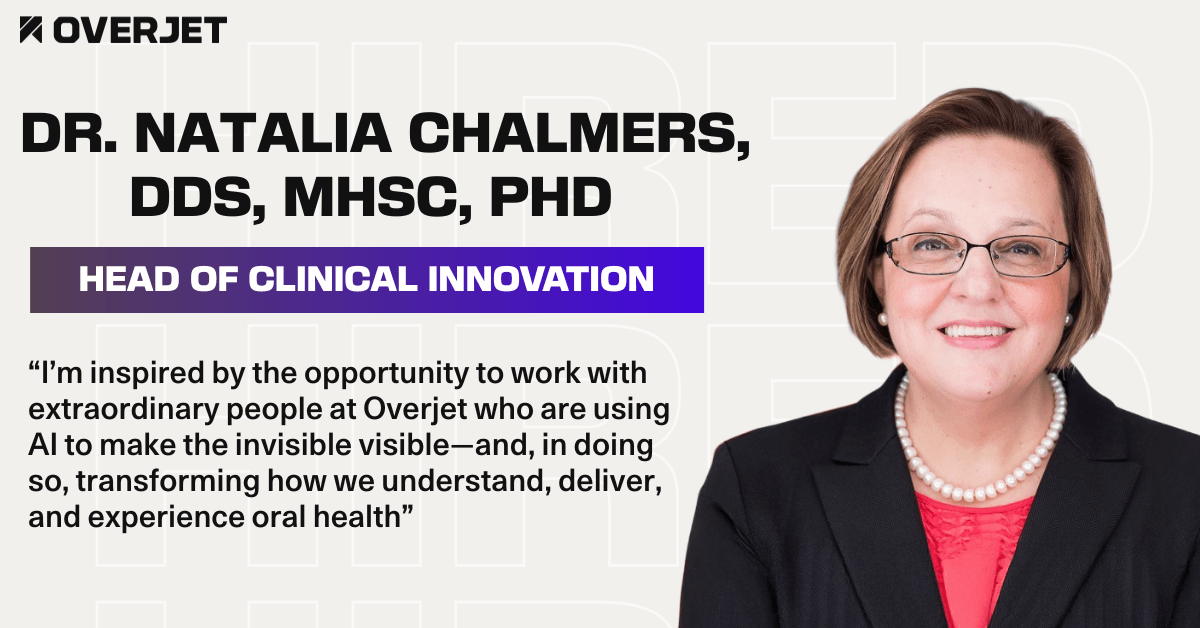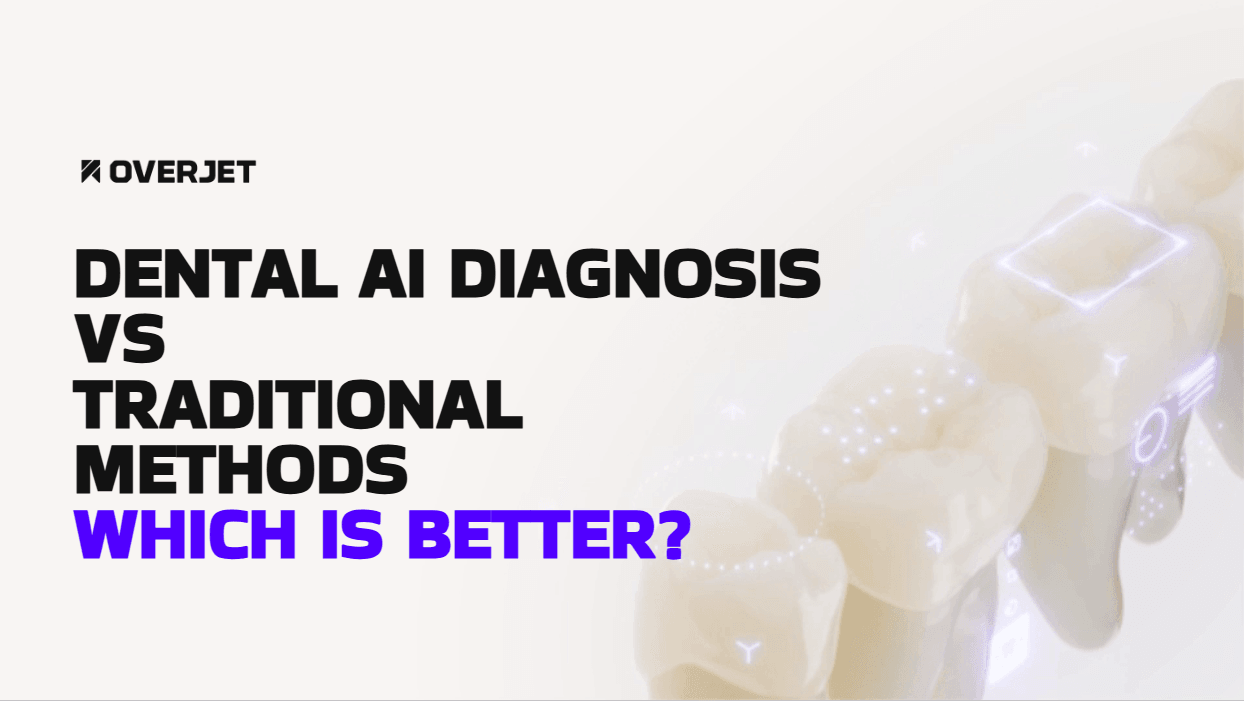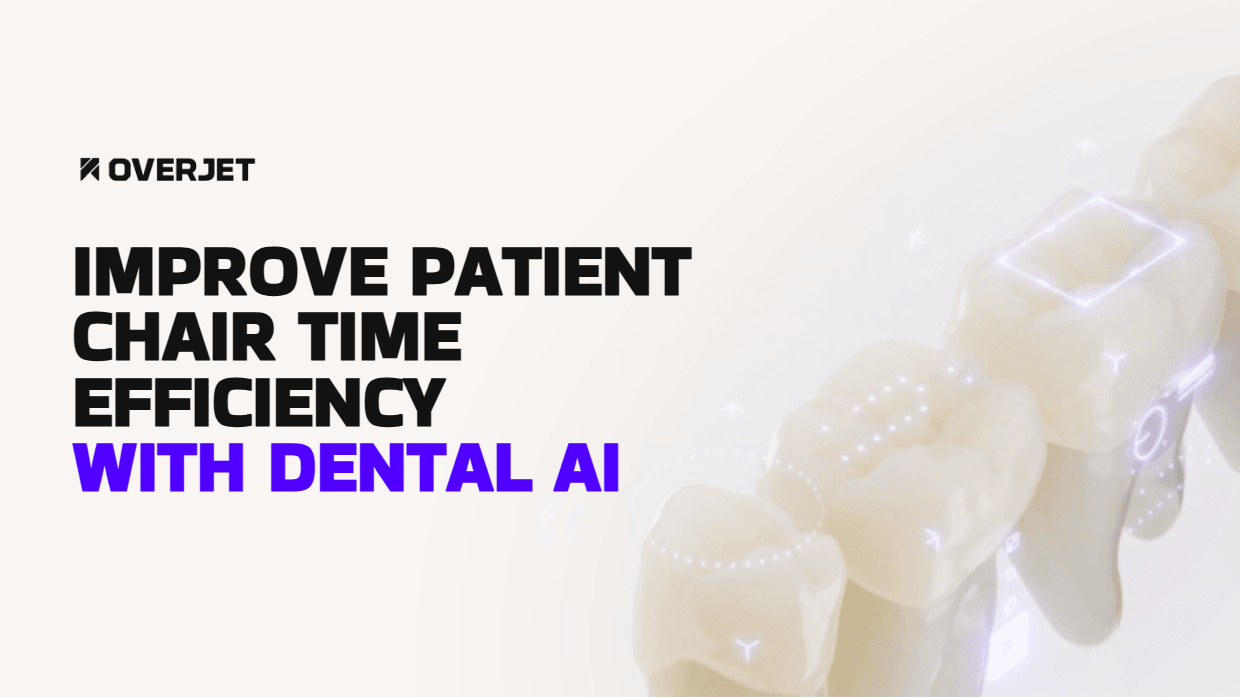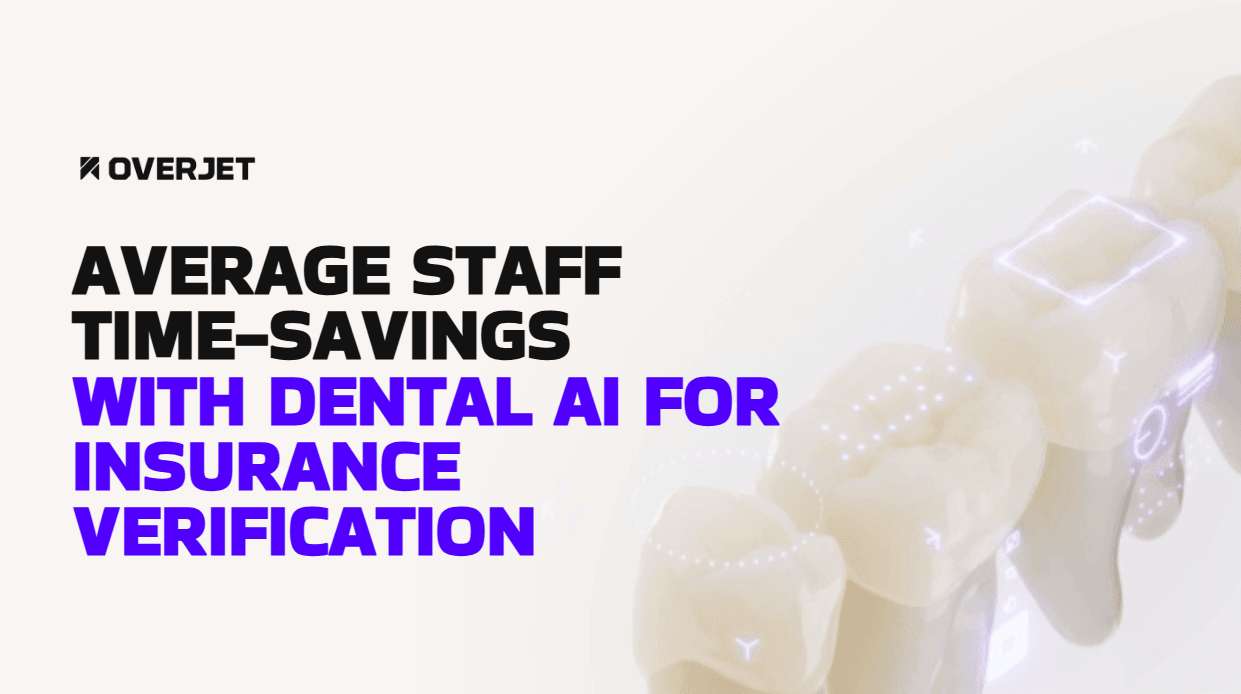Front office teams spend an average of 10-15 minutes often spend significant time per patient verifying insurance benefits manually, time that adds up to hours of lost productivity daily, while patients wait and schedules fall behind. When verification data is outdated or incomplete, the downstream cost multiplies: claim denials, resubmissions, patient billing disputes, and eroded trust.
AI-driven tools automate eligibility verification by extracting patient data, performing real-time payer checks, and surfacing accurate coverage details in seconds, eliminating phone calls, reducing errors, and improving clean claim rates. This article explores how AI transforms verification workflows, prevents dental-specific denials, and delivers measurable ROI for practices and DSOs.
Explore Overjet's Dental AI Software
What Is Dental Patient Eligibility Verification
Dental patient eligibility verification confirms a patient’s insurance benefits before treatment begins. AI-driven tools automate this process by extracting and validating patient data in real-time, cross-referencing it against payer databases to surface accurate co-pay estimates, frequency limits, and coverage restrictions, eliminating manual phone calls and reducing claim denials caused by outdated information.
Dental eligibility differs from general medical verification in important ways. Annual maximums cap total benefits per year, frequency limits restrict how often certain procedures receive coverage, and missing tooth clauses may exclude prosthetics for teeth lost before coverage began. Payers also apply downgrades, covering composite fillings at amalgam rates or limiting crown materials, that affect what patients pay out of pocket.
Core Data Elements Checked
AI systems validate multiple data points simultaneously:
Active coverage status: Confirms the member is eligible on the date of service and identifies plan type (PPO, HMO, DHMO, indemnity)
Deductible amounts: Verifies individual and family deductibles, remaining amounts, and whether preventive services are exempt
Annual maximums: Checks total and remaining benefits for the year, plus in-network and out-of-network differences
Frequency limitations: Validates timing restrictions for procedures like cleanings every six months or bitewings once per year
Waiting periods and exclusions: Identifies waiting periods for major restorative work, missing tooth clauses, implant coverage restrictions, and age limits for orthodontics or sealants
Typical Timing Within the Patient Journey
Eligibility verification happens at three critical moments. At scheduling, front office staff gather payer and member details and pre-check benefits to set patient expectations. At check-in, real-time verification captures any changes, plan switches, benefit year resets, or newly added dependents, that occurred between booking and arrival. Before major procedures like crowns or implants, practices re-verify to avoid denials from frequency conflicts or waiting periods that weren’t flagged earlier.
Timely verification improves clean claim rates by reducing outdated benefit usage and preventing coding conflicts that trigger rejections.
Why Manual Verification Fails in High-Volume Dental Settings
Traditional phone-based or portal-based verification struggles under volume and variability. Front office teams juggle different payer portals, inconsistent benefit formats, and lengthy hold times, often spending ten to fifteen minutes per verification while patients wait and schedules fall behind.
Delay-Driven Claim Denials
Manual workflows produce outdated benefit snapshots because of delays between scheduling and treatment. A patient books a crown in November with $800 remaining on their annual maximum, but by the December appointment, their benefit year has reset, or they’ve used benefits elsewhere. Mid-year employer plan switches and frequency limit changes lead to denials when the verified data no longer reflects current coverage.
Staffing Costs and Burnout
Front office staff spend significant time on repetitive tasks like calling payers, navigating multiple portals, and manually entering data into the practice management system. This contributes to burnout and turnover, especially across multi-site organizations where processes vary by office and institutional knowledge walks out the door with departing employees.
Patient Experience Impacts
Verification delays translate to longer check-in times and unexpected patient balances after treatment. When a patient learns post-treatment that their cleaning wasn’t covered due to a frequency limit or their crown exceeded their maximum, the billing surprise damages trust and increases payment friction. These experiences impact patient retention, online reviews, and referrals.
How AI-Powered Insurance Verification Works Step By Step
AI dental insurance verification automates the end-to-end process by ingesting patient and payer data, performing real-time eligibility checks, interpreting responses, and surfacing clear guidance directly in the practice management system. Overjet’s approach emphasizes automation, dental-specific rule interpretation, and chairside usability, ensuring clinical and administrative teams have accurate information without switching systems.
1. Ingest Insurance Card and Patient Data
AI uses optical character recognition (OCR) to capture payer name, member ID, group number, and subscriber information from images of insurance cards. OCR is a technology that converts images of text into machine-readable data, eliminating manual transcription errors. The system also parses data from the PMS, demographics, scheduled procedures, and provider NPI, to match the correct plan and prepare real-time checksOverjet uses advanced technology to automatically retrieve and interpret patient eligibility and benefits information.
2. Submit Real-Time EDI 270 Transactions
An EDI 270 is an electronic inquiry that requests current eligibility and benefit information directly from the payer. The AI system automatically generates and transmits 270 transactions, then retrieves the payer’s 271 response, a structured file containing coverage details, deductibles, maximums, and plan notes. This eliminates manual portal logins and phone calls, deliveringThe system electronically checks with payers to obtain up-to-date eligibility and benefit details, eliminating the need for manual phone calls or portal logins and allowing staff to access benefit information in seconds rather than minutes.
3. Apply NLP to Payer 271 Responses
Payers often return complex, payer-specific language in 271 responses and supplemental benefit PDFs. Natural language processing (NLP) standardizes and interprets responses, extracting deductible amounts, annual maximums, coverage percentages, and plan notes, even when information appears in free text or inconsistent formatsOverjet’s technology reads and simplifies complex payer responses, ensuring teams see key coverage details and exclusions, even if information is presented in different formats or free text. NLP also identifies coverage exclusions and waiting periods buried in narrative descriptions, surfacing them as actionable alerts.
4. Cross-Check Dental Frequency Limits
The system applies dental-specific rules to confirm that planned procedures comply with frequency, age, and tooth-level restrictions. For example, D1110 prophylaxis every six months, D4341 periodontal scaling with site-specific requirements, and radiograph intervals based on patient risk and payer policy. It flags potential conflicts before treatment, alerting the team that a patient’s last cleaning was four months ago or that a planned bitewing set will be denied because the previous set was taken eight months prior.
5. Surface Chairside Alerts in PMS
Verified benefits and alerts display directly in the PMS or via sidebar overlays, showing coverage levels, remaining maximums, frequency warnings, and downgrade notices. Clinicians and front office staff see this information without switching systems, enabling informed treatment planning and accurate financial conversations at the point of care. Overjet’s integration ensures that diagnostic findings from radiograph AI and eligibility data appear side by side, connecting clinical recommendations with real-time coverage insights.
Key Benefits for DSOs and Multi-Site Practices
AI-powered verification delivers measurable operational and financial improvements, especially for organizations managing high patient volumes across multiple locations.
Faster Check-In and Reduced Wait Times
Instant, automated eligibility checks eliminate payer hold times and portal hopping. Front desk staff complete check-in in half the time, improving patient satisfaction and allowing the schedule to run on time even when appointment volumes surge.
Higher Clean Claim Rate
Clean claims are those accepted by payers without edits or requests for additional information. When eligibility data is accurate and up to date, coding aligns with plan rules, reducing denials for frequency violations, missing authorizations, or benefit exhaustionOverjet helps ensure claims are submitted accurately and approved quickly. Higher clean claim rates mean faster reimbursement, less rework, and improved cash flow.
Lower Administrative Overhead
Automation frees staff from repetitive tasks, enabling reallocation toward case acceptance, patient communication, and scheduling optimization. Instead of spending hours on verification calls, team members focus on treatment coordination and financial counseling, activities that directly impact case acceptance and revenue.
Consistent Processes Across Offices
Standardized verification rules, templates, and audit logs drive uniform practice across sites, regardless of local staffing levels or experience. New hires onboard faster because the system handles complex verification logic, and compliance teams gain visibility into verification quality across the organization.
Dental-Specific Denials AI Can Prevent
AI tuned for dentistry prevents issues that general healthcare tools may overlook by applying CDT-aware rules and dental coverage logic.
Missing Tooth Clause Exclusions
Plans may exclude prosthetics for teeth missing before coverage started, a provision known as a missing tooth clause. AI cross-references historical charts, radiographs, and prior claims to flag exclusions and recommend alternatives, like a resin-bonded bridge instead of an implant, or advise on pre-authorization strategies that document the tooth’s extraction date relative to coverage.
Implant and Crown Downgrades
Insurers may downgrade procedures to less costly alternatives, covering implants at the rate of a fixed bridge or limiting crown materials to base metal instead of porcelain-fused-to-metal. AI predicts likely downgrades based on payer policies and alerts teams to estimate patient responsibility accurately, preventing post-treatment billing disputes and improving case acceptance by setting realistic expectations upfront.
Frequency and Age Limit Violations
Common restrictions include prophy and fluoride intervals, sealant age caps, and orthodontic age ranges. AI checks procedure history and patient age against payer criteria to prevent denials before scheduling or treatment, flagging when a planned service will be rejected and suggesting alternative timing or coding.
Safeguarding HIPAA and Payer Compliance With AI
AI systems handle protected health information (PHI) throughout ingestion, processing, and output, requiring robust security and compliance controls.
Encryption and Access Controls
Data is encrypted in transit and at rest using industry-standard protocols like TLS and AES-256. Role-based access controls, least-privilege permissions, and multi-factor authentication limit exposure to only necessary staff and systems, ensuring that eligibility data flows securely between the PMS, AI platform, and clearinghouse without unauthorized access.
Continuous Audit Trails
Comprehensive logs capture who accessed what, when, and why, creating a timestamped record of every verification, data change, and system interaction. Audit trails support compliance reporting, payer audits, and internal oversight across multi-site organizations, providing transparency and accountability that manual processes can’t match.
Integrating AI Tools With PMS, Imaging, and Clearinghouses
Successful deployments connect AI verification with PMS data, imaging systems, and clearinghouses to ensure end-to-end eligibility, coding, and claims flow. Overjet integrates with leading dental technology stacks, including Dentrix, Eaglesoft, Open Dental, and Curve, to streamline adoption and reduce change management friction with management systems, to streamline eligibility verification.
API and FHIR Connectivity
APIs (application programming interfaces) and FHIR (Fast Healthcare Interoperability Resources) are standardized methods for systems to exchange healthcare data securely and reliably. Using standards like FHIR enables seamless, real-time data sync between the AI platform, PMS, imaging, and clearinghouse systems, eliminating manual exports, imports, and duplicate data entry.
Mapping CDT Codes to Eligibility Rules
The AI system links CDT procedure codes to plan-specific coverage rules, frequency limits, downgrades, and age restrictions, validating treatment plans against benefits automatically. When a hygienist charts D1110 and D0274, the system instantly checks the patient’s prophy and bitewing frequency, surfacing alerts if either service will be denied, allowing the team to adjust the plan or counsel the patient before proceeding.
Measuring ROI: Core KPIs to Track Post-Implementation
Tracking operational and financial outcomes before and after implementation quantifies value and guides optimization.
Eligibility Verification Accuracy Rate
Measure the percentage of verifications that correctly reflect final payer adjudication by comparing verified benefits against remittance outcomes for corresponding claims. An accuracy rate above 95% indicates the AI is reliably interpreting payer responses and dental-specific rules.
First-Pass Acceptance Ratio
Track the proportion of claims paid or accepted without edits on first submission. Improvements here often correlate with higher verification accuracy and better handling of frequency limits and downgrades, directly impacting cash flow and reducing administrative rework.
Staff Time Saved Per Claim
Estimate the reduction in manual minutes per verification by sampling pre- and post-implementation workflows, calls, portal time, data entry, and extrapolating across claim volumePractices may experience improved efficiency and accuracy with Overjet’s AI-driven eligibility verification. A practice processing 100 verifications daily that saves five minutes per check gains over eight hours of staff capacity weekly.
Days Sales Outstanding Reduction
DSO (days sales outstanding) measures the average time to collect payment. Faster, more accurate verification shortens the revenue cycle by reducing denials, resubmissions, and patient billing disputes, accelerating cash conversion and improving financial predictability.
Future Outlook: Linking Radiograph Insights to Real-Time Coverage
Emerging capabilities link diagnostic AI with eligibility to anticipate coverage outcomes and streamline approvals. Overjet’s vision connects radiograph-driven clinical insights with real-time benefits, enabling proactive financial and clinical planning that improves case acceptance and reduces administrative friction.
AI Prediction of Likely Payer Acceptance
By analyzing imaging findings, like bone loss severity, caries depth, or restoration margins, and historical payer behavior, AI estimates approval likelihood for specific procedures. This guides case presentation and pre-authorization strategies, helping teams prioritize treatments with high approval probability and prepare stronger documentation for borderline cases.
Automated Pre-Authorization Generation
AI can assemble payer-specific prior authorization packets automatically, attaching radiographs, narratives, periodontal charts, and codes in the format each payer requires. This accelerates approvals and reduces administrative friction, turning a task that once took thirty minutes into a one-click workflow.
Advancing Eligibility Verification With Overjet Dental AI
Overjet delivers AI-powered eligibility verification tailored to dentistry, combining automated 270/271 checks, NLP interpretation, dental frequency validation, and chairside PMS integration. As part of a comprehensive dental AI platform, Overjet also enhances diagnostics, clinical consistency, and revenue performance, connecting imaging insights with administrative workflows to support better patient outcomes and operational efficiency.
Ready to See Overjet's Dental AI in Action?
Frequently Asked Questions (FAQs)
How long does AI dental eligibility verification implementation typically take?
Implementation timelines depend on practice size and existing tech stack. Most practices achieve full deployment within a few weeks following configuration, integrations, and brief staff training.
Can solo dental practices justify the cost of AI eligibility verification?
Solo practices benefit from reduced administrative effort, fewer denials, and improved cash flow. Subscription models scale to smaller operations, aligning cost with usage and value.
Does AI eligibility verification replace front office staff completely?
AI augments staff by handling routine verification and data normalization. Teams then focus on patient communication, treatment coordination, and complex cases requiring human judgment.









